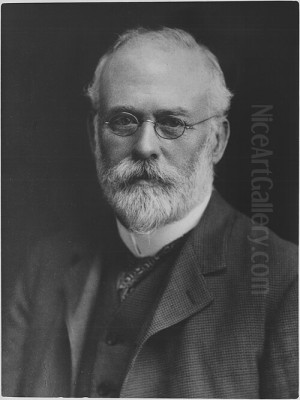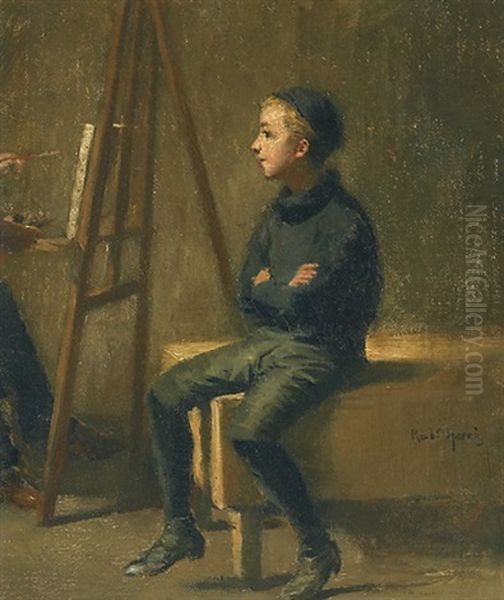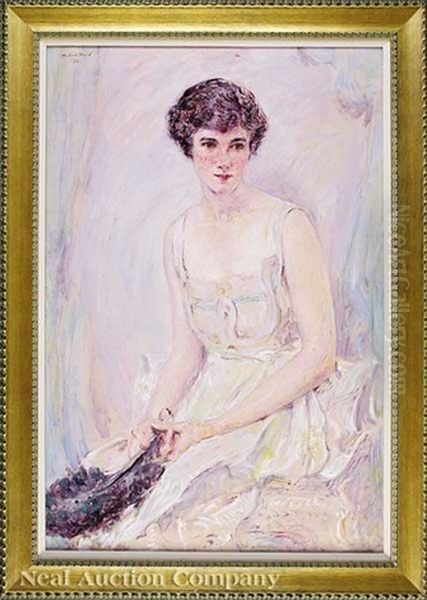
Robert Harris (1849-1919) stands as one of Canada's most distinguished painters, primarily celebrated for his insightful portraiture and his significant contributions to the burgeoning Canadian art scene in the late 19th and early 20th centuries. Born in Vale of Conwy, Caernarfonshire, Wales, Harris's artistic journey was shaped by diverse cultural landscapes, from his formative years in Prince Edward Island to his extensive studies and professional life across Europe and North America. His legacy is not only etched in the canvases he left behind but also in his foundational role in Canadian art institutions.
Early Life and Transatlantic Beginnings
Robert Harris was born on September 18, 1849, into a family that would soon seek new opportunities across the Atlantic. In 1856, at the age of seven, he emigrated with his family from Wales to Charlottetown, Prince Edward Island. This move to what was then a British colony, and would later become a province of Canada, placed the young Harris in a new environment that would subtly influence his perspective. His early artistic inclinations were nurtured in this setting, though formal training opportunities were limited.
The desire for a comprehensive art education led him to travel. He initially studied in Boston, Massachusetts, a significant artistic hub in North America at the time. His pursuit of knowledge then took him to London, England, where he enrolled at the prestigious Slade School of Art under Alphonse Legros, a painter and etcher known for his sober realism. Legros, a Frenchman who became a naturalized British citizen, had himself studied with Horace Lecoq de Boisbaudran, known for his memory training methods, which likely influenced Legros's teaching.

Harris's educational odyssey continued in Paris, the undisputed center of the art world in the 19th century. There, he studied under Léon Bonnat at the École des Beaux-Arts. Bonnat was a highly respected academic painter, renowned for his portraiture and religious paintings, and his atelier attracted students from around the globe, including American artists like Thomas Eakins and G.P.A. Healy. The academic tradition, with its emphasis on draftsmanship, anatomical accuracy, and carefully constructed compositions, profoundly shaped Harris's technical skills and artistic approach. While in Paris, he would have been aware of the revolutionary movements of Impressionism, championed by artists like Claude Monet and Edgar Degas, though Harris's own style remained more closely aligned with the established academic conventions, albeit infused with a personal sensitivity.
Establishing a Career in Canada
After his extensive training abroad, Robert Harris returned to Canada, initially settling in Toronto in 1879. Toronto was a growing city, and Harris began to establish his reputation as a skilled portraitist. His ability to capture not just a likeness but also the character of his sitters quickly brought him commissions. However, it was Montreal that would become his permanent home and the primary center of his professional life from 1883 onwards. Montreal, at the time, was Canada's largest city and its economic powerhouse, boasting a vibrant cultural life and a wealthy clientele eager for portraits.
Harris's talent did not go unnoticed. He became an influential figure in the Canadian art community. His European training and evident skill set him apart, and he was keen to contribute to the development of a distinct Canadian artistic identity. This period saw him produce a significant body of work, primarily portraits of prominent Canadians, including politicians, businessmen, academics, and their families. His style was characterized by its refined realism, careful attention to detail, and a sympathetic portrayal of his subjects.
He was not working in a vacuum. The Canadian art scene, while still developing, included other notable figures. Lucius O'Brien, for instance, was a prominent landscape painter and the first president of the Royal Canadian Academy of Arts. Homer Watson was gaining recognition for his depictions of the Southern Ontario landscape, often compared to the work of the English master John Constable. In Quebec, artists like Napoléon Bourassa and Ozias Leduc were also contributing to the cultural fabric, though Leduc's more symbolist and introspective style differed significantly from Harris's academic realism.
The Royal Canadian Academy of Arts and National Recognition

A pivotal moment in Robert Harris's career, and in the history of Canadian art, was the founding of the Royal Canadian Academy of Arts (RCA) in 1880. The initiative was spearheaded by the Marquis of Lorne, then Governor General of Canada, and his wife, Princess Louise. Harris was not only a founding member but also played an active and crucial role in the Academy's early years. The RCA was established to foster the development of the visual arts in Canada through exhibitions, education, and the creation of a national collection.
Harris's commitment to the RCA was unwavering. He served as its president from 1893 to 1906, a period during which he worked tirelessly to promote Canadian art and artists both domestically and internationally. One of his significant achievements during his presidency was organizing the Canadian art exhibit at the World's Columbian Exposition in Chicago in 1893. This was a major international event, and ensuring a strong Canadian presence was vital for showcasing the nation's cultural achievements on a global stage. His efforts helped to raise the profile of Canadian artists and demonstrate the growing maturity of the country's art scene.
His leadership at the RCA placed him at the center of artistic discourse in Canada. He interacted with many leading artists of the day, including William Brymner, who was also a key figure in art education in Montreal, and George Agnew Reid, known for his large-scale figure paintings and murals. While these artists pursued their own distinct paths, their collective efforts through institutions like the RCA were instrumental in building a professional artistic community in Canada.
The Fathers of Confederation: An Iconic Commission
Perhaps Robert Harris's most famous and historically significant work was The Fathers of Confederation. Commissioned by the federal government in 1883, this monumental painting was intended to commemorate the Charlottetown and Quebec Conferences of 1864, which laid the groundwork for Canadian Confederation in 1867. The painting depicted the delegates to the Quebec Conference. Harris was chosen for this prestigious commission due to his established reputation as a leading portraitist.
The task was immense. Harris had to depict thirty-three figures, many of whom were deceased or for whom only limited visual references existed. He undertook extensive research, traveling to gather likenesses from photographs, existing portraits, and even from life, where possible. He created numerous preparatory sketches and studies for individual figures and for the overall composition. The final canvas, completed in 1884, was a masterful group portrait, skillfully arranging the figures in a dignified and historically resonant scene within the Quebec legislative chamber.
The painting was lauded for its technical skill and its powerful evocation of a seminal moment in Canadian history. It hung in the Centre Block of the Parliament Buildings in Ottawa, becoming an iconic image of Canadian nationhood. Tragically, the original painting was destroyed in the fire that consumed the Parliament Buildings on February 3, 1916. Only Harris's full-scale charcoal sketch (cartoon) survived, which is now housed in the collection of the National Gallery of Canada. The loss of the painting was a significant blow to Canada's artistic heritage, but the surviving sketch and numerous photographic reproductions ensure that Harris's vision of this historic event endures. The inspiration for tackling such a grand historical subject reportedly came from a conversation Harris had with a teacher, Kate Henderson, who suggested the theme.
Notable Works and Thematic Concerns
While The Fathers of Confederation is his most widely recognized work, Robert Harris produced an extensive oeuvre, estimated at over 300 portraits, alongside other genre scenes and compositions. Several of these works reveal his keen observational skills and his empathetic approach to his subjects.
The Newsboy (1879), also known as A Meeting of the Newsboys, is an early example of his interest in everyday life and his sympathetic portrayal of children. The painting depicts a group of young newspaper sellers, capturing a sense of their youthful energy and the realities of their working lives. This work demonstrates Harris's ability to move beyond formal portraiture and engage with social themes.
The Meeting of the School Trustees (1885-86) is another significant genre painting. It features a determined rural school teacher, Kate Henderson (the same woman who reportedly inspired The Fathers of Confederation), arguing her case before a group of male school trustees. The painting is celebrated for its nuanced portrayal of gender dynamics and its subtle feminist undertones, highlighting the challenges faced by women in professional roles during that era. The composition, lighting, and characterization in this work are particularly strong, making it one of his most compelling narrative pieces.
Bessie and Her Wedding Dress (1885), a portrait of his wife, Elizabeth (Bessie) Putnam, is a more intimate work. It showcases his skill in capturing delicate textures, such as the fabric of the wedding dress, and in conveying a sense of personal affection and quiet contemplation. His portraits of women often displayed a particular sensitivity, moving beyond mere likeness to explore their inner lives. This "feminist tendency" noted by critics suggests an artist attuned to the evolving social roles and perceptions of women.
His portraits of prominent figures, such as Sir John A. Macdonald or Lord Strathcona, were executed with the dignity and gravitas expected of such commissions, yet they often retained a sense of the sitter's individual personality. Harris's ability to balance formal requirements with psychological insight was a hallmark of his portraiture.
Artistic Style and Technique
Robert Harris's artistic style was firmly rooted in the academic tradition he absorbed during his studies in London and Paris, particularly under Léon Bonnat. This tradition emphasized strong draftsmanship, a realistic representation of form, carefully balanced compositions, and a polished finish. His portraits are characterized by their clarity, their solid modeling of figures, and their often-somber but rich color palettes.
He was a master of capturing likeness, but his best portraits went further, offering a glimpse into the sitter's character and social standing. He paid close attention to details of costume and setting, using them to enhance the portrayal of the individual. His handling of light was typically controlled and used to model form effectively, often creating a subtle dramatic effect without resorting to overt theatricality. Unlike the Impressionists, such as his French contemporaries Pierre-Auguste Renoir or Berthe Morisot, who were exploring the fleeting effects of light and color in outdoor scenes, Harris's focus remained on the studio portrait and the carefully constructed narrative scene.
While his style might be considered conservative by the standards of European avant-garde movements of his time, it was perfectly suited to the tastes and needs of his Canadian clientele. His work provided a sense of stability, dignity, and historical continuity for a young nation forging its identity. His commitment to realism was not merely photographic; it was infused with an artistic intelligence that sought to convey deeper truths about his subjects and their society. He was less experimental than, say, James Wilson Morrice, a Canadian contemporary who embraced Impressionist and Post-Impressionist influences in his European and Canadian scenes. Harris's strength lay in his consistent, high-quality execution within the established conventions of portraiture and figure painting.
Influence, Contemporaries, and Legacy
Robert Harris's influence on Canadian art was substantial, extending beyond his own paintings. As a teacher at the Art Association of Montreal (which later became the Montreal Museum of Fine Arts) and through his long tenure as President of the RCA, he helped shape the careers of younger artists and set standards for artistic practice in Canada. He was a respected figure, known for his professionalism and his dedication to the cause of Canadian art.
He operated within a Canadian art world that was steadily growing. Artists like Wyatt Eaton, another Canadian who studied in Paris under Jean-Léon Gérôme (a contemporary of Bonnat), also brought back academic skills to North America. The landscape tradition, strong in Canada, was being advanced by artists like Lawren Harris (no relation, and a later generation) who would become a key member of the Group of Seven, pushing Canadian art in a more modernist direction after Robert Harris's era. However, during Robert Harris's prime, the dominant trends were still largely influenced by European academicism and later, Impressionism.
Internationally, the world of portraiture was vibrant. John Singer Sargent, an American expatriate, was dazzling London and Paris with his bravura brushwork and psychologically penetrating portraits. James McNeill Whistler, another American in London, was pursuing a more aesthetic and tonal approach. While Harris's style was perhaps less flamboyant than Sargent's or as overtly aesthetic as Whistler's, he shared with them a commitment to capturing the essence of the sitter. In France, academic painters like William-Adolphe Bouguereau continued to enjoy immense popularity, even as Impressionism gained ground. Harris's work can be seen as part of this broader late 19th-century tradition of skilled, realistic portraiture.
His legacy is that of a foundational figure. He provided Canada with a visual record of its leading citizens and pivotal historical moments. His dedication to art education and institutions helped to professionalize the art world in Canada. While later movements would take Canadian art in new directions, Harris's contribution remains undeniable. He was, in many ways, Canada's first truly national painter of stature in the field of portraiture.
Later Years and Anecdotes
In his later years, Robert Harris continued to paint, though his health began to decline. One poignant anecdote relates that towards the end of his life, he suffered from failing eyesight and was nearly blind, largely confined to his sofa. Despite this, he remained engaged with the art world, reportedly acting as a "gentle critic," always ready to find merit in the work of his fellow artists. This speaks to a generous spirit and a lifelong passion for art.
His dedication to his craft was evident throughout his life. The story of Kate Henderson inspiring The Fathers of Confederation and later appearing as the central figure in The Meeting of the School Trustees highlights the interconnectedness of his life and art, and his responsiveness to the people and ideas around him. His willingness to shift from grand historical commissions to intimate genre scenes or formal portraits demonstrates his versatility.
Robert Harris passed away in Montreal on February 27, 1919, at the age of 69. He left behind a rich legacy of artworks that continue to be studied and appreciated for their artistic merit and their historical importance. His papers, including correspondence and diaries, are preserved in the Confederation Centre Art Gallery in Charlottetown, providing valuable insights into his life, his working methods, and the Canadian art world of his time.
Conclusion: A Lasting Impression
Robert Harris was more than just a skilled painter; he was an institution builder, an educator, and a chronicler of his time. From his early training in the great art centers of Europe to his distinguished career in Canada, he consistently demonstrated a high level of technical proficiency and a deep understanding of his subjects. His portraits offer a window into the society of late 19th and early 20th-century Canada, capturing the personalities that shaped the nation.
His most famous work, The Fathers of Confederation, though lost, remains an enduring symbol of Canadian identity, testament to his ability to rise to a national artistic challenge. Works like The Meeting of the School Trustees reveal a progressive sensibility and a talent for narrative composition. As a founding member and long-serving president of the Royal Canadian Academy of Arts, he played an indispensable role in fostering a professional art community in Canada. While artistic styles have evolved, Robert Harris's contribution to the foundations of Canadian art history is secure, his work a dignified and insightful reflection of an era. He remains a pivotal figure, whose brushstrokes helped to paint the portrait of a young nation.